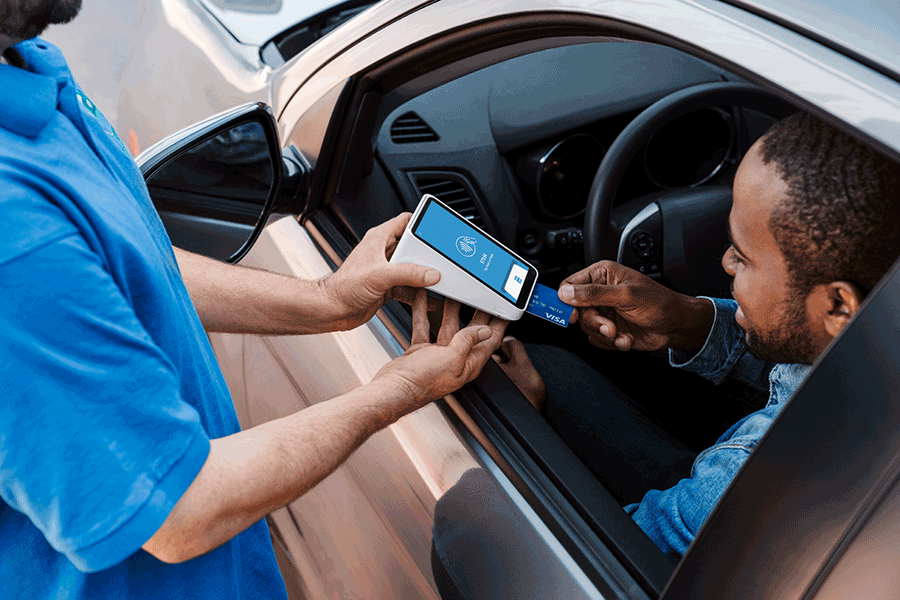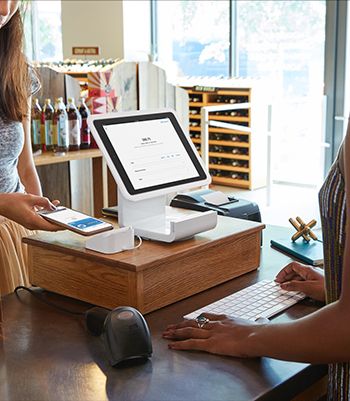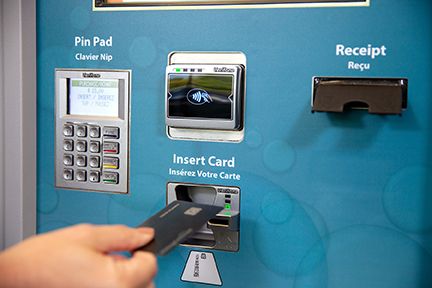
POS: Changing with the Times

By Angela Altass
Point of sale (POS) systems have evolved over time with contactless capabilities and software-as-a-service (SaaS), also known as cloud-based software, along with increased mobile/online ordering and delivery rising to priority status.
Improved hardware, enhanced program offerings, better metric analysis, and the trend to SaaS, and an increase in contactless options; are some of the changes that have occurred over recent years, notes Lee Barter, senior vice president, Infonet Technology Corporation.
“We have had different contactless options available for some time, allowing for TAP as well as Apple Pay, Google Pay, etc.,” says Barter. “These will, of course, advance with time. We have also developed a contactless app for iOS and Android for payments at the pump.”
 Ease of use, dynamic reporting, integration to multiple processors, loyalty and gift card offerings, contactless payments as well as proper and timely product support are all important in today’s POS world, says Barter.
Ease of use, dynamic reporting, integration to multiple processors, loyalty and gift card offerings, contactless payments as well as proper and timely product support are all important in today’s POS world, says Barter.
“We have completed a large number of changes in our software offering for customers allowing for enhanced reporting; integration to customer loyalty and account card offerings, Petrotrak fleet card processing certification for Moneris Solutions customers, EMV certification for Bennett dispensers for U.S. customers, enhanced TAP capability as well as other contactless options including RFID, tablet offering for POS and pump control, dispense based marketing media, warehouse capacity for inventory management and store-to-store transfers,” says Barter.
Additional improvements and new product/software offerings are anticipated for the future, based on customer and market demands, with a push towards an e-commerce capacity based on customer desire to embrace online product ordering for delivery and pick-up, notes Barter.
Retailers are looking for expanded solutions, including frictionless, online and mobile options, says John Coyle, vice president of sales, ADD Systems.
“They are also making sure they can better enforce age-restricted sales, like tobacco and alcohol purchases,” says Coyle. Interest in contactless capabilities has definitely increased and we are not expecting that interest to subside. The new frictionless experience further defines convenience and sets the bar higher. Mobile/online ordering and delivery have become standard during the pandemic and now that people have seen how convenient and easy it is, they won’t want to turn back.”
Since the POS system is on the front end and is customer-facing, it is important that integration enables devices and does not slow down engagement or cause problems with wrong prices, states Coyle.
“We strive for true integration where we can provide two-way, seamless communication and sharing of data,” says Coyle. “Pulling back all the transactional data from the POS and into our system is where the true benefit of data analysis is realized. We can reference transaction counts for hiring decisions, sales data by vendor for better negotiation, market basket analysis for promo discussions, inventory analysis for tighter inventory control and more. With all the data the POS can provide, the analysis opportunities are endless.”
Mobile Apps
Carwash consumers are increasingly demanding mobile applications, notes Rich Carpenter, director of product development and customer programs for DRB In-Bay Solutions.
“We have been working with several partners who develop apps that integrate with our Unitec brand of pay stations,” says Carpenter. “Features vary by application. Apps that have unlimited wash program functionality are particularly attractive to c-store carwash operators, offering them a simpler way to offer those plans to their customers.”
Consumers want to be able to purchase carwashes at any pay point in the convenience store or forecourt so the carwash POS should be able to facilitate that option, says Carpenter.
 “It should also accommodate commonly used payment methods, whether that’s credit/debit cards, mobile payments or cash,” says Carpenter. “The POS system is a key tool to help the c-store carwash operators grow and manage their wash businesses. To that end, the POS system should be able to effectively upsell consumers to increase ticket averages and incentivize return visits and loyalty. Operators also expect their POS to provide real-time access to key business data on all of their locations from a single access point.”
“It should also accommodate commonly used payment methods, whether that’s credit/debit cards, mobile payments or cash,” says Carpenter. “The POS system is a key tool to help the c-store carwash operators grow and manage their wash businesses. To that end, the POS system should be able to effectively upsell consumers to increase ticket averages and incentivize return visits and loyalty. Operators also expect their POS to provide real-time access to key business data on all of their locations from a single access point.”
The most recent trend is moving software from an on-site application to a hybrid cloud architecture, notes Carpenter.
“In this model, key services, such as POS user interfaces, wash communications and payments, are driven through an on-premise appliance with important data being synced to the cloud so operators can run their washes remotely and have information easily shared between multiple sites,” says Carpenter. “This approach simplifies software, provides a secure data repository and simplifies carwash management for the multi-site operator.”
While the pandemic may have been a catalyst for the increased interest in contactless capabilities, contactless will remain a preferred method of payment due to simplicity of use, says Carpenter.
“The desire for contactless payments has also been a big driver of the interest in carwash apps, allowing the consumer to activate the carwash directly through the app,” says Carpenter. “We are always looking for the next big thing in our industry and we are excited for what 2021 will bring as people get back to business and travel again.”
 Many Canadian convenience stores or carwashes have grown accustomed to keypad card machines to close their sales, says Karisa Marra, business expert, Square Canada.
Many Canadian convenience stores or carwashes have grown accustomed to keypad card machines to close their sales, says Karisa Marra, business expert, Square Canada.
“It’s a familiar solution but it’s wildly outdated,” she states. “Products, such as Square Terminal, offer convenience stores and carwashes with a modern, elegant device with point of sale software that handles all updates to the terminal seamlessly through overnight, automatic and free software updates. At Square, we design our own hardware and software in house and it’s integrated so that means businesses always have the latest technology at their fingertips.”
Launched in Canada in February 2021, Square for Retail allows businesses to manage their inventory with less stress and better reach their customers wherever they are, says Marra.
Square for Retail’s seamless integration with Square Online lets retailers sell online, in-store and on social media, while the inventory management tool allows them print barcode labels, track inventory across locations, create reports and manage purchase orders. The all-in-one POS also provides insights into inventory performance, tracks costs and monitors profits.
“Due to the integration with Square Online, this solution could help convenience stores with things like in-store pick-up and barcode scanning,” says Marra. “It simplifies two aspects that retailers without a tailored POS find overly time-consuming and complicated: selling anywhere and managing their inventory. Businesses looking for the ideal POS system require a solution that has everything they need to start, run and adapt their business. At the most basic level, a POS system should be able to do the following: accept any type of payment method that crosses the counter, handle employee and cashier permissions, and keep track of customer records and transactions for reporting, accounting and refund purposes.”
A POS solution should help retailers run their businesses, says Marra.
“This involves the ability to integrate and add on functionality that is tailored to each small and mid-size business,” says Marra. “For example, some need an integrated loyalty program to reward customers and others need integrated invoicing to run their businesses. Many others need an integrated online store to be able to handle customers orders and inventory that occur online, offline or both, such as online orders placed for curbside pick-up or local delivery.”
In addition to businesses adapting cashless options, there has been an acceleration in omnichannel commerce trends with adoption by sellers of all sizes, says Marra.
“E-commerce is here to stay as COVID-19 fast-tracked what was inevitable for many businesses – the move to online,” she says. “While some businesses were already on this path, one big trend Square has seen is that the lengthy, sometimes years-long adoption cycle of moving online has been shortened to as little as three weeks as the pandemic has made online selling an immediate need for businesses. Digital order channels are becoming more common and expected as consumers can now shop through not only a business website but through other methods, including social media.”
In response to the pandemic, contactless payments have adapted their processing methods as more consumers increasingly want to pay in the way they feel most comfortable, whether that is in-person, online or mobile, says Marra.
“In the Canadian retail sector the share of transactions being made through contactless payment options shot up from 4.6 per cent in February 2020 to 35.9 per cent in April when social distancing guidelines were the strictest,” says Marra. “As restrictions eased, contactless payment counts moderated but have remained more than twice as high as they were before the pandemic.”
Consumer expectations and behaviour may change forever with buyers expecting more options for how they can make purchases, says Marra.
“Even as cities reopen, consumer behaviour will likely vary as some may still be more comfortable with options like curbside pick-up and delivery, especially in the short-term,” states Marra. “Customers have now experienced more ways to buy and we don’t see the demand for that going away. We’ve also seen that one source of traffic won’t cut it. Businesses will need to continue to meet buyers wherever they are. Being able to visit a shop, accept online orders, do business virtually or in-person, engage through social media channels and email has opened up more opportunities to do even more business.”


































